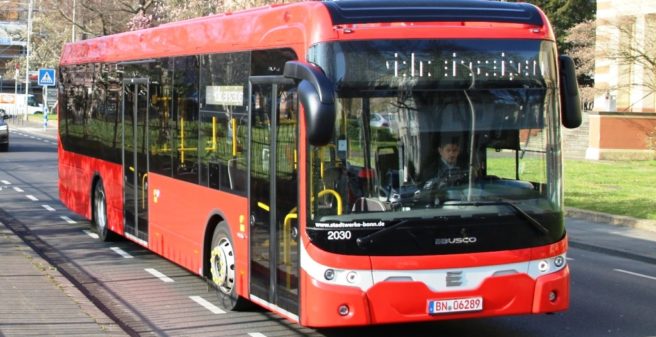
INDUSTRY FOCUS: Alternative Propulsion Systems
On 16 and 17 March, the 12th Electric Bus Conference of the Association of German Transport Companies (Verband Deutscher Verkehrsunternehmen – VDV) took place but not like in previous years at the Hotel Estrel in Berlin. Instead, the approximately 500 participants got together digitally via internet. Only the the conference moderation took place at the hotel.
As in previous years, an exhibition of currently available electric buses was also part of the event. In the past, the buses were presented “hands-on” in rooms next to the large conference hall where the actual conference took place. This way of presentation really created the flair of a bus fair similar tothe IAA Commercial Vehicles in Hanover and Busworld in Brussels. Not so this year: although the exhibition was divided into “halls”, the buses were presented digitally on the internet …
Greetings by Secretary of State Zieschang
As it should be, the conference was opened with greetings. State Secretary Zieschang from the Federal Ministry of Transport and Digital Infrastructure (BMVI) began by stating that an important breakthrough had been achieved achieved in the field of electric buses. By 2020, she said, the number of electric buses in use in Germany willwould have increased by 155%. Currently, there are more than 1,000 electric buses and roughly 100 buses with fuel cell hydrogen drives in use in Germany. It is estimated that by 2030 approximately 32.5%, of all buses will be completely emission-free.
Electric buses are still more expensive than conventional ones with combustion engines, but thanks to the “Förderrichtlinie Elektromobilität” (Electric Mobility Funding Guideline), 80% of all additional costs incurred by the purchase of electric buses will be covered in the form of grants. In the course of the second quarter of 2021, another positive subsidy decision to enhance the purchase of electric buses is expected from the EU within the framework of its “Electric Mobility Subsidy Directive”.
Greetings by Cem Özdemir, Chairman of the Bundestag Transport Committee
Cem Özdemir, a well-known politician of the Green Party and Chairman of the Transport Committee of the Bundestag, focused his remarks on the “Future of Mobility”.
He began his speech with a look at the development of passenger numbers in local public transport during the Corona pandemic. At times, the slump was as steep as 80% (!). At present, 50 to 60% of the passengers who used to travel by public transport before Corona are again using buses and trains. However, Özdemir warned against the illusion that there would be a quick return to the old transport figures. That would take several years. Nevertheless, he left no doubt: “We want to get back there. And before Corona, more people travelled by public transport year after year, and we also want to pick up on these rates of increase again.”
Özdemir made it clear: “This decade is the decade of the (electric) bus.” It is simply not possible to handle all transport by rail. Topographically, railways cannot reach every corner of Germany. But it is also impossible – not least for cost reasons – to create the infrastructure that would be necessary to serve all traffic exclusively by rail.
Per Özdemir, “Transport turnaround does not mean that we tell people which means of transport they must use to get from A to B. If we want them to use the public transport system, we have to tell them how to get there. If we want them to use public transport, then public transport must be attractive. This can be done with attractive vehicles, with attractive journey times, if possible without any need to change buses.“ A bus that drives past the traffic jam in a separate, truly free lane is no less attractive than a railway.
Another sentence of Özdemir’s made people sit up and take notice: “No one is helped if planes stay on the ground.” So it is only logical that Özdemir called for the “intelligent networking” of all (!) modes of transport. The private car explicitly included.
He pointed to the European Union’s “Clean Vehicle Directive”, which prescribes by what date how many of our buses must be emissions-free. The Federal Government and the Bundestag naturally support this directive. However, this also means a major transformation for our transport companies, to which the Federal Government must also provide support, regardless of the technology the respective transport company has chosen. It must also be ensured, he said, that when electricity is supplied, all vehicles in the depot are supplied as equally as possible.
The time of the combustion engine in transport is over, not only in public transport, but also and especially in passenger cars. Literally, he said, “The decade of the electric bus has begun.” As examples of exemplary electric bus concepts, he mentioned the BOB (battery trolleybuses) in Solingen and the hydrogen buses at Regionalverkehr Köln and Wuppertal WSW. For Özdemir emphasised that the fuel cell bus is also an electric bus.
Özdemir added that it is not possible to dictate from the outside which alternative propulsion system is the best in each case. “The best solutions are always found on site.”
NOW GmbH – a Federal Government initiative – Chairman Knobelsdorff
The Federal Government has created the limited liability company NOW GmbH, a wholly-owned subsidiary, to promote the introduction of transport means with alternative drives. NOW stands for “National Organisation for Hydrogen and Fuel Cell Technology.” NOW chairman Knobelsdorff stressed that the federal funding programme is “technology-open” because it does not favour any specific drive technology. There is no fundamentally best solution for powering the vehicles, rather “there is only the right technology for the respective very specific application.”
Knobelsdorff emphasised that battery-electric buses are ready for series production. The fuel-cell bus is not quite there, but its readiness for series production is also imminent. A major procurement directive provides good funding opportunities for buses with alternative drives, he said. While this also includes trolleybuses, Knobelsdorff added that probably no one today would set up a completely trolleybus-covered route network. In-motion charging is the more attractive option: On the incline, where the bus requires additional power, there is an overhead line from which the bus draws its traction current, and at the same time it also charges its batteries. The rest of the route is then powered by its batteries. The BOB (battery trolley buses) in Solingen are an example. Marburg is also planning such a system: here, the university clinics are located on the Lahn Hills, and the route to them is relatively steep from the north and south. Marburg wants to drive with in-motion chargers in the future, taking advantage of in-motion chargers’ ability to store recuperated electricity in their batteries during braking and thus reuse it.
Finally, Knobelsdorff pointed out that feasibility studies can also be subsidised from the funding pots. With the help of state funds, it is possible to investigate which alternative drive concept is the best for one’s own purpose.
Key Note Presentation by Prof. Schrödl, TU Vienna
A very interesting presentation entitled “The Future of Electric Drive Systems” was given by Professor Dr. Manfred Schrödl from the Vienna University of Technology.
He began with the provocative question whether hydrogen be reserved for industry only, rather than being used for transport. But he immediately rejected such thoughts himself: a hydrogen-powered bus would be ideal for intercity transport in sparsely populated regions. A battery bus would have to haul too large batteries there, or a recharging infrastructure would have to be created in very remote locations.
When the electric bus becomes established, its drivetrain will cost only a third of what it costs today for an internal combustion engine. “The electric motor is technically much simpler …!” At the same time, Schrödl showed a compelling illustration: First, a passenger car with luggage in the boot at the rear and an internal combustion engine in the engine compartment. Slide 2 depicts the same car with an electric motor. The boot is as full of luggage as before. However, given the much smaller electric motor, the engine compartment could hold three additional suitcases! Schrödl literally spoke of the “triple output”: the battery vehicle is
- – technically much simpler
- – has – with the same energy input – a significantly higher range
- – and three times the output.
.
A battery bus today, he said, has a mileage capacity of approximately one million kilometres with its first battery, and that is without any significant reduction in the battery’s storage capacity. At the same time, Schrödl dispelled the claim that rare earths are needed to manufacture batteries. He called this thesis simply wrong. He also said that the mining of lithium is not harmful to the environment. Moreover, it can be mined underground. The cost of lithium for the battery of an electric bus is only 20 euros. And in general, the prices for batteries are decreasing.
“At the same time,” says Professor Schrödl, “the ranges of the batteries have increased significantly.” (Note: five years ago (2016), electric buses still failed because they did not achieve the range of 200 kilometres promised by the manufacturer. Today, manufacturers can assure ranges of 400 kilometres with a clear conscience).
Schrödl also commented on the price of battery buses versus hydrogen buses: the latter is 35% more expensive than a battery bus.
On the cost side of electric vehicles, Schrödl said that as early as 2025, an electric car could be cheaper than a car with a combustion engine.
He also addressed the impact the additional demand for electric power might have if the transport sector were to be completely converted to electric drives. To demonstrate that the additional demand for electricity would not be substantial, he provided an example of one wind turbine being able to sufficiently generate the necessary traction current for 14 battery-powered railway locomotives, which have a much higher energy demand than buses. If the entire transport sector were to be converted to electric propulsion, there would be an additional demand for electricity of 20%. As this additional supply of electricity would not have to be available overnight, but could be fed in gradually over many years, it would be possible to build up the necessary infrastructure in the power supply without any problems.
If, on the other hand, the transport sector were to be completely converted to hydrogen propulsion, there would be an additional demand for electricity of 60%, exclusively for the production of the necessary hydrogen alone. Nevertheless, Schrödl left no doubt that hydrogen will be an important energy storage medium in the future. If there is too much electricity in the grid, it makes sense to store it in the form of hydrogen, because hydrogen, unlike electricity, is technically very easy to store. And when electricity consumption is high, the hydrogen can be converted back into electricity.
Professor Schrödl concluded his presentation by pointing out that electricity recuperated during braking cannot be stored in a pure hydrogen vehicle. If you want to recuperate, a hydrogen bus also needs a battery.
The bus as part of “Germany mobile 2030”
The speaker, Mr. Maximilian Rohs, said: “Within the framework of the project “Germany mobile 2030”, the bus will be an essential milestone for the future of public transport.” For the modal split, the aim is to achieve an increase of more than 30% for public transport. For bus transport, this means on the one hand the “drive turnaround” and on the other hand significantly more vehicles. The number of buses on offer must be increased by 35%. In 2018, there were 54,000 buses in Germany’s public transport system; by 2030, more than 66,000 buses will be needed. At the end of 2020, there would be around 700 electric buses on the road in German public transport, which compared to the end of 2019 means that the number of electric buses has more than doubled in just one year, in part due to the “Clean Vehicle Procurement Act”. Rohs summed up accordingly: “The decade of the electric bus has begun.”
The goal is to shift passenger-kilometres away from motorised individual transport to public transport. Among other things, this requires a higher quality of public transport compared to private transport. This is where a system comes into play that is still almost completely unknown in Germany: BRT – Bus Rapid Transit – similar to a train on a separate track, but much faster and also cheaper to implement.
Examples of electric bus operations
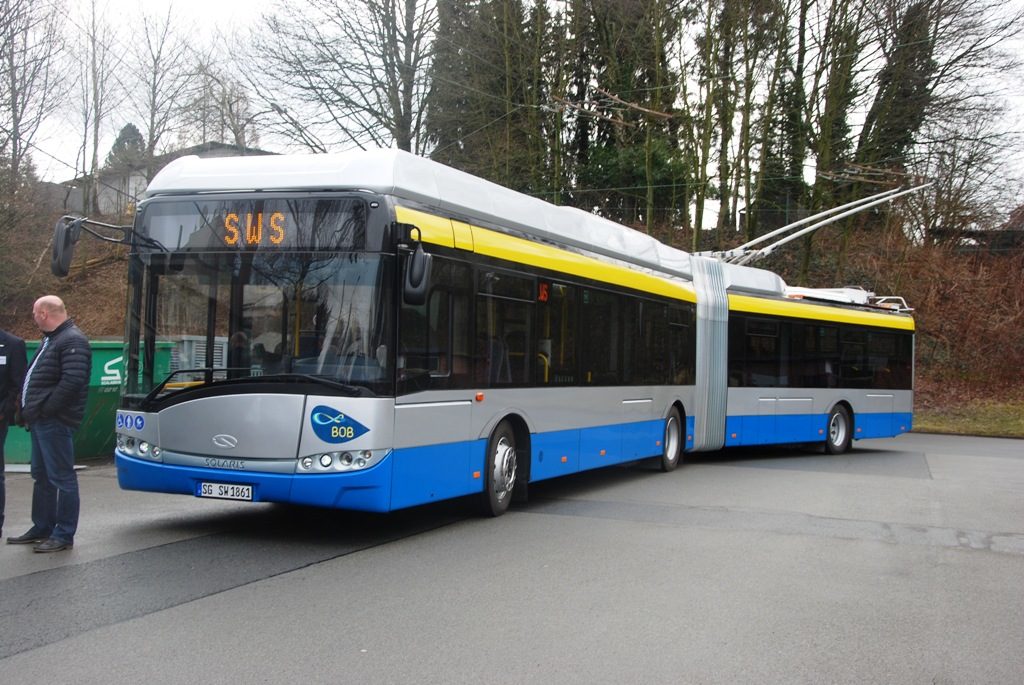
Solingen – SWS
It is a traditional part of the VDV’s electric bus conferences that companies report on their experiences with their electric buses. Stadtwerke Solingen, for example, presented their experiences with their BOB (battery trolleybuses). Solingen currently has the largest trolleybus network in Germany with six pure trolleybus lines (lines 681 to 686); in October 2019 the seventh BOB line 695 has been added. On its route from Abteiweg to Meigen, the 695 used to run with diesel buses for a large part of the route under the overhead line of trolleybus line 683 – without using it, of course.
Then came the sensible idea of having a bus that uses a catenary line where it exists, but runs on battery power where there is no catenary line. The conceptual birth of the BOB. Apart from a recharging mast erected at the Abteiweg terminus as a precautionary measure to prevent a BOB from stopping here in winter with an empty battery, the conversion of line 695 did not require any investment in additional overhead lines.
The cars consumed 2.3 kWh per kilometre. SWS’ employee Adrian Dogge was very satisfied with the BOB project and now Solingen is thinking of converting the entire bus service to BOB. In this regard, together with the Bergische University in the neighbouring city of Wuppertal, they have developed a computer-based procedure with which the entire bus network can be simulated as an intelligent control system.
For the conversion of further diesel bus lines to BOB, new overhead lines will probably be needed here and there in the city. On the other hand, due to the complete overhead lines for the trolley buses in the entire city, there are also sections of the route on which one might not need any overhead lines at all. However, nothing has been decided in this direction yet.
Solingen has ordered 32 more battery-powered trolleybuses from Solaris for the expansion of its BOB system: 16 single and 16 articulated trolleybuses each. As Solingen has not had any solo trolleybuses for some time, the future solo BOBs must be intended to replace diesel 12 metre trolleybuses.
Göteborg/Sweden – Västtrafik
In Gothenburg, Sweden’s second largest city, and the surrounding area, “Västtrafik” operates bus services. Västtrafik belongs to the French Keolis Group.
Gothenburg began using buses with electric drives as early as 2011. This involved three examples of an experimental vehicle from Volvo with a very futuristic appearance, which were used on one line together with conventional diesel buses. In 2013, the brand new Line 55 followed, the first line in Gothenburg exclusively for electric buses. Here, too, Volvo supplied the buses. On 13 December last year, 146 new articulated electric buses from Volvo went into service at once. They are “opportunity chargers”, i.e. cars that are recharged on the line. To supply them all with the necessary traction current, 19 charging stations have been set up throughout the city.
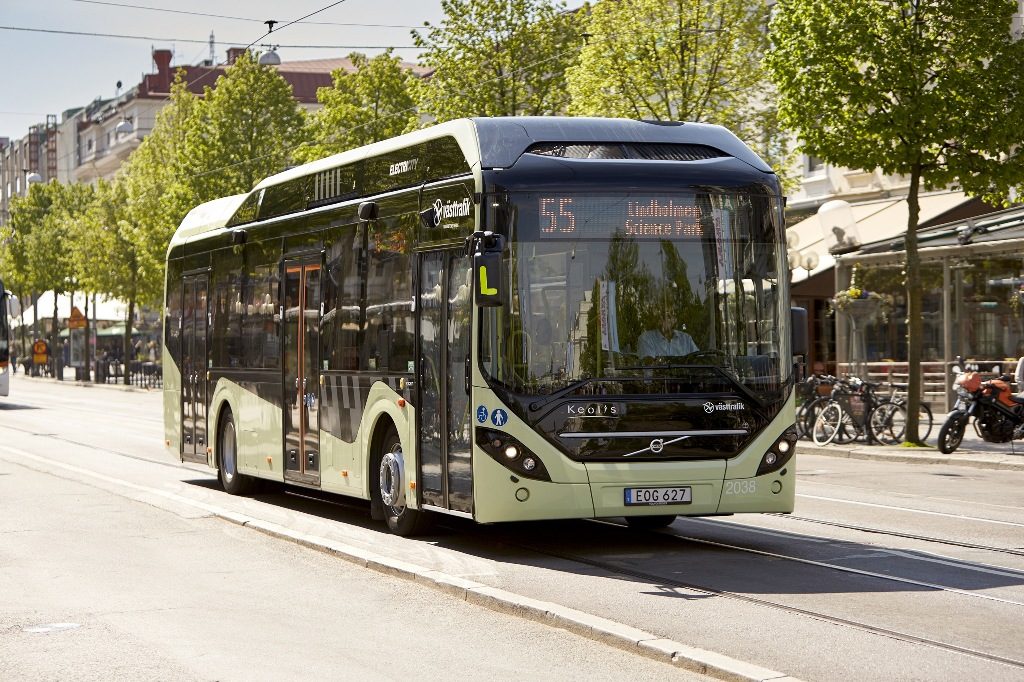
The current fleet consists of 210 buses. As early as 2025, Västtrafik wants to operate 97% of its buses with alternative drives, and by 2030 it wants to have only electric buses in its fleet.
Västtrafik representative, Hanna Björk, reported a nice detail from the city of Lidköping, which is with Västtrafik’s service area. Here, only 11 buses are needed for the entire city transport, all of which are electric buses from Volvo. Björk: “Lidköping is Europe’s only city where the city transport is served only by electric buses.“
The electric bus exhibition
Here we have chosen some examples of virtual exhibits at the Elekbu 2021:
Ebusco
Ebusco from Deurne in the Netherlands (Eindhoven metropolitan area) was founded in 2012 and has been developing more and more into an important player on the German market as well. They have already delivered several vehicles to Munich’s MVG. Electric buses from Ebusco are in use at DB subsidiaries (for example in the Bocholt city transport system). In Eisenach at the “Wartburgmobil”, and you will soon be able to see them on the line in Bonn. A large number of articulated electric buses have just been delivered for the Dutch “R-Net” (greater Amsterdam region).
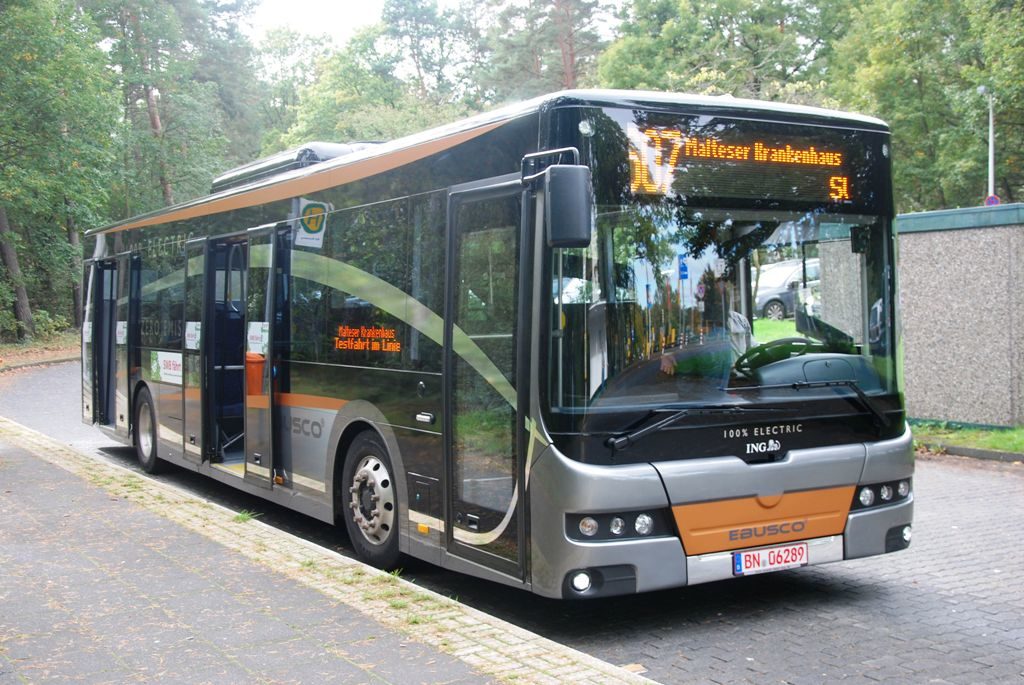
In 2013, Ebusco provided the Bonn SWB with a first demonstration vehicle (Generation 1). In terms of bodywork, it was a Chinese Golden Dragon, which Ebusco had completed as an electric bus. Today, Ebusco supplies its Generation „2.2″ buses. They are available as 12-metre long solo buses and as 18-metre long articulated buses. A larger order for 18-metre long Ebusco 2.2 articulated buses was recently delivered to the Dutch “R-Net”.
And a few days ago, Ebusco delivered four Ebusco 2.2 to DB subsidiary RVO for its depot in Bad Tölz. The range of electric buses today is illustrated by the transfer of the coaches from the factory in Deurne to Bad Tölz. The wagons did not arrive at their future place of use on a low-loader, but on their own axles. For this purpose, the route from Deurne to Bad Tölz was divided into four stages. At the destination of each stage, the batteries of the four Ebusco were recharged and then the journey continued. The first stage led over about 150 kilometres from the factory in Deurne to Bonn under the charging stations at SWB’s Friesdorf depot. The second stage was also about 150 kilometres to Frankfurt to the Transdev depot. Stage three covered a good 200 kilometres to Nuremberg to the VAG depot. After a good 500 kilometres since the Deurne plant, an overnight stay was made in Nuremberg. Here, the buses’ batteries (and the drivers) were thoroughly recharged. The next day was the final stage of about 250 kilometres from Nuremberg to Bad Tölz.
Why are we describing this overpass so thoroughly? Quite simply: only a short time ago, the transfer of electric buses over almost 800 kilometres on their own axle would have been considered impossible. The range of the batteries would simply not have been sufficient. Of course, electric buses still have to recharge three times on such a tour, but due to the increased range of today’s batteries, it is possible!
In October 2019, Ebusco presented the prototype of its new “Ebusco 3.0” at its factory in Deurne. It is no longer made of steel, but of composite plastic. Its lighter weight reduces its power consumption and increases its range accordingly. Further, while previous electric buses like to have their batteries on the roof or in “boxes” in the rear (where diesel buses have their engines), the Ebusco 3.0 has its battery “underfloor” under the floor. Because the Ebusco 3.0 is still a low-floor bus (!), its batteries must be emphatically flat. If one is curious about the new electric bus from Deurne, the first Ebusco 3.0 from the series is to be delivered to the Munich MVG in autumn.
.
Hess
From neighbouring Switzerland comes “Carrosserie Hess AG”. The company was founded approximately 100 years ago in Solothurn. Today it is based in the neighbouring town of Bellach.
Originally, Hess was a coach builder, then for decades it supplied bodies on the chassis of the renowned Swiss commercial vehicle manufacturers Saurer, FBW and Berna. When these companies ceased to exist, Hess focused on coach building for diesel buses built on the Scania chassis. Hess also has a side production of passenger trailers for buses. Since Göppel closed its doors, Hess is the only remaining manufacturer of bus trailers in Western Europe.
In the case of trolleybuses, however, the company became a supplier of complete vehicles: the „SwissTrolley“ trolleybus series was created. The articulated trolleybuses also bear the sub-name “LighTram”.
Hess is a leader in the field of double-articulated trolleybuses. These 25 metre trolleybuses are used with good success in Lucerne and Zurich, for example. Hess now also offers them as “in-motion chargers”.
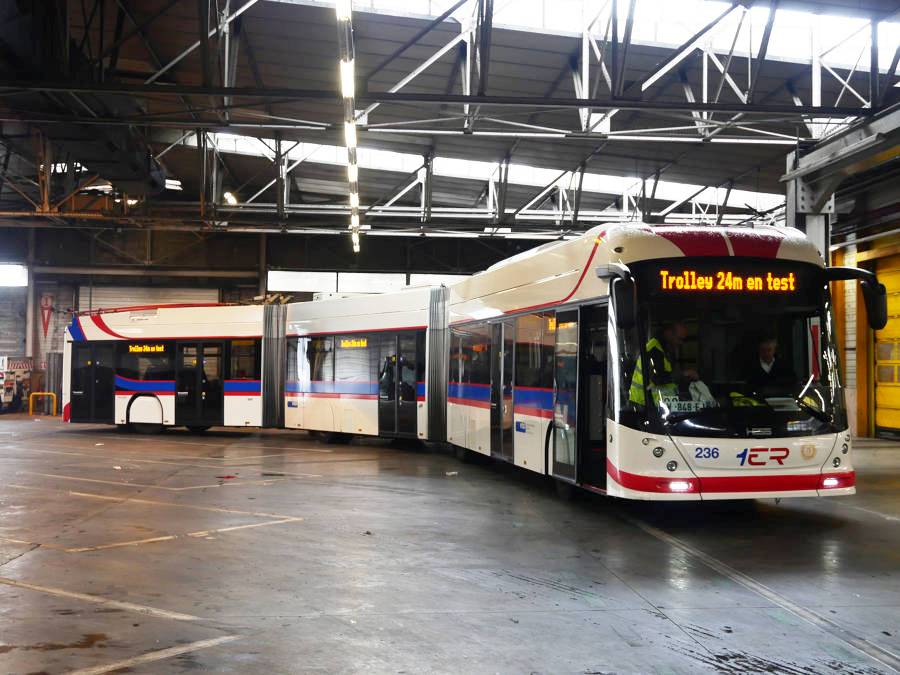
There are also battery-electric buses from Hess. Two such 12-metre buses were delivered to the RNV in Mannheim. Their batteries were inductively recharged according to Bombardier’s “Primove” system. The operation of the two Primove buses in Mannheim was terminated, with both cars awaiting resale.
MAN
The subsidiary of the VW Group announced the start of series production of its “Lion’s City E 12” and “Lion’s City E 18” electric buses. The first large order for the articulated bus has already been received from VAG in Nuremberg.
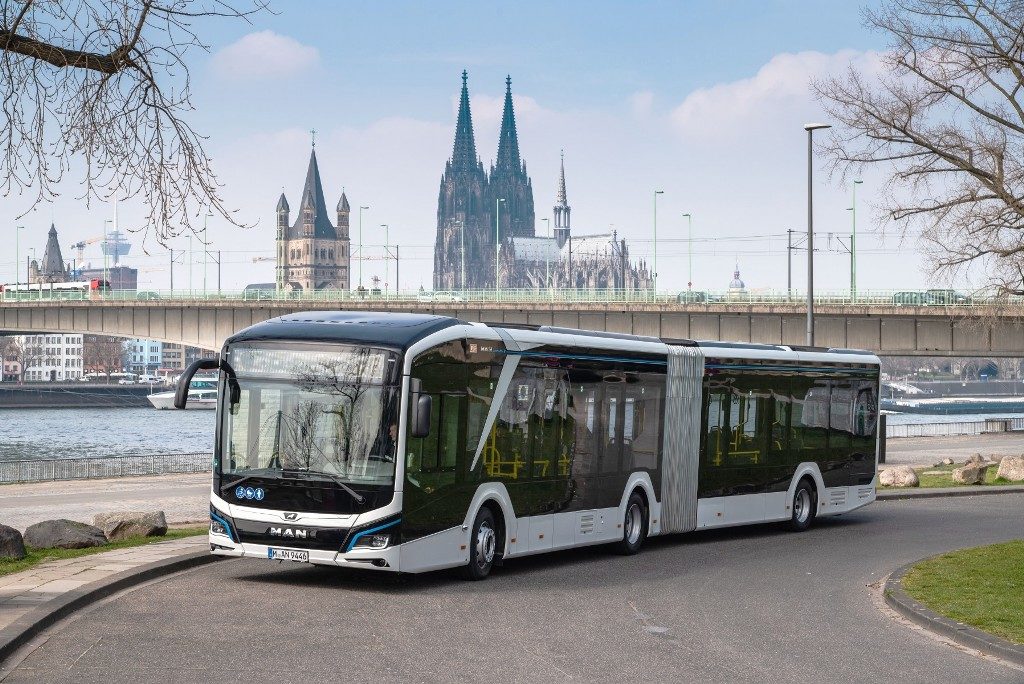
Quantron
The name Quantron is still relatively new on the electric bus market. The Augsburg-based company emerged from the commercial vehicle dealer Haller from neighbouring Gersthofen; Haller is an authorised dealer for Iveco.
Quantron imports the electric buses of the Turkish manufacturer Karsan to Germany. These include the Jest minibus and the Atak midibus, both of which have an electric drive train from BMW. What is new is that Quantron now also puts the “Quantron” logo on the front of the buses in addition to the Karsan trademark.
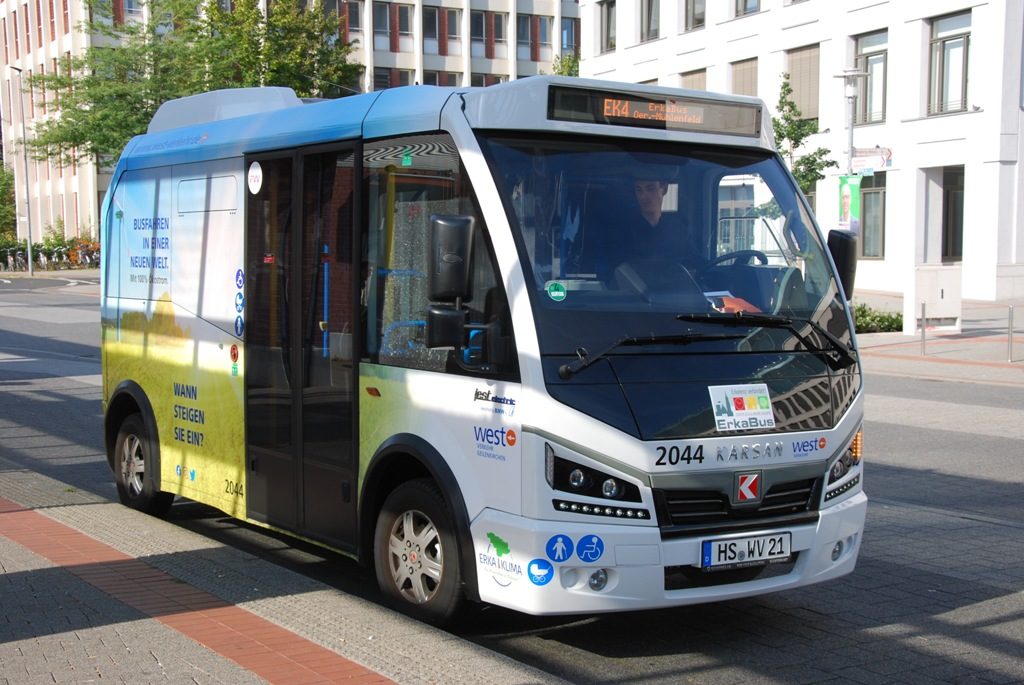
Additionally, Quantron is engaged in converting commercial vehicles from diesel to electric drive. Quantron is not alone in this; other retrofitters include Etrofit and I see Buses. All retrofitters argue:
- – we ensure that your bus is environmentally friendly on the road
- – we give your bus a second life (i.e. I see Buses’ successful conversion of two 2011 MAN Lion’s City Üs to electric drive for DB subsidiary Autokraft)
whereby the latter is almost more important.
.
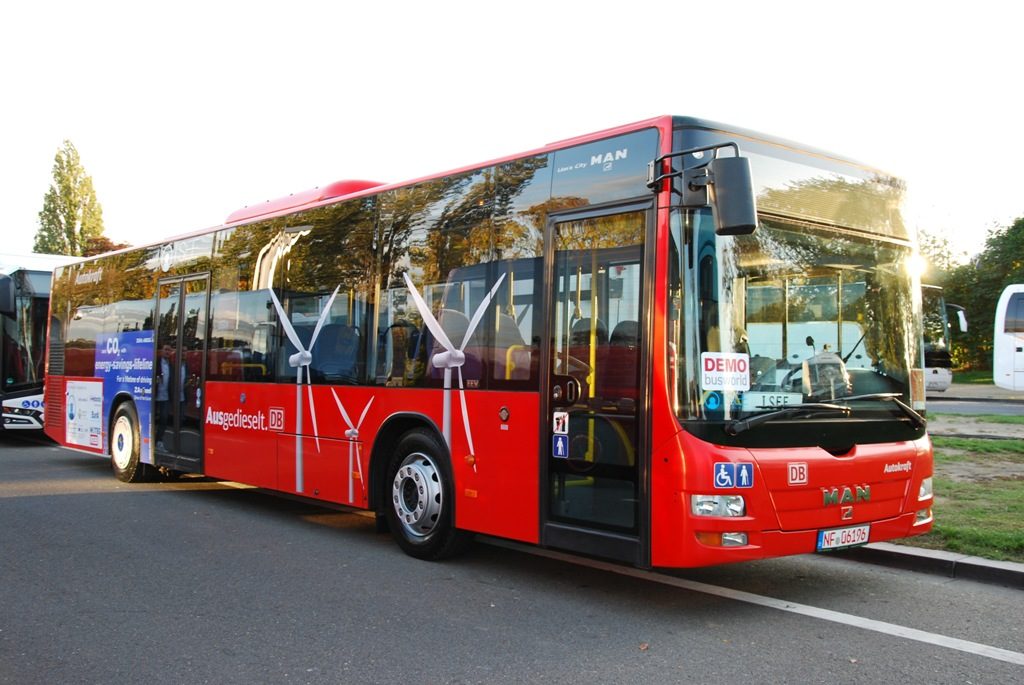
Quantron is now expanding its range of brand-new electric buses to include full-grown buses. At the fair, the Augsburg-based company presented its “Quantron ebus 12” and its big articulated brother, the “Quantron ebus 18”.
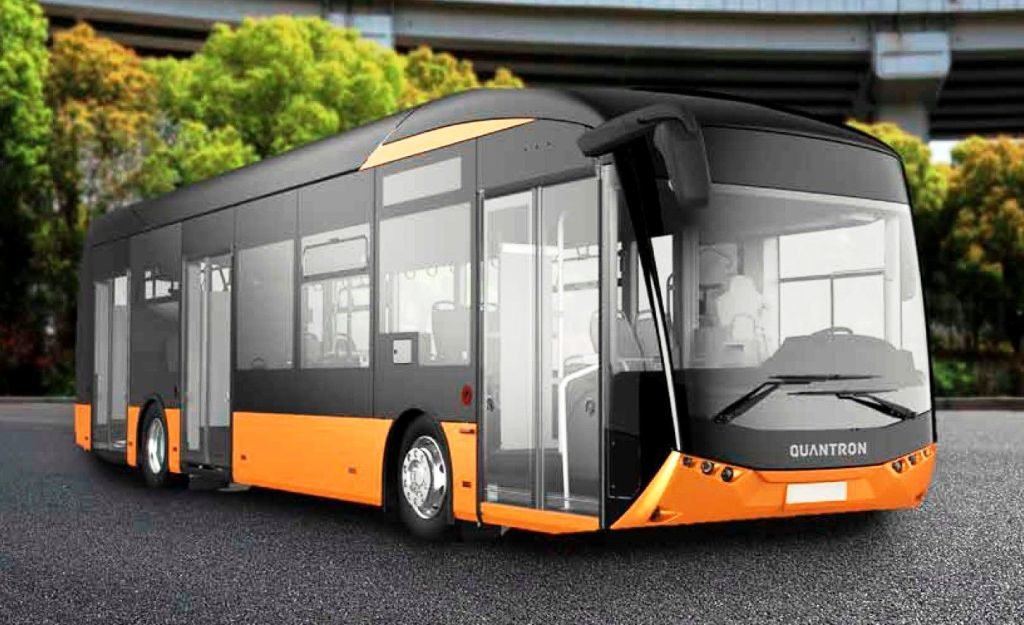
Solaris
On 22 March 1996, Solaris, a Polish bus manufacturer from Bolechowo near Poznan, completed its first bus ever, a three-door bus with the name “Urbino” (urbs (Latin) = city). Solaris soon enjoyed considerable success on the international bus markets. For many years, Germany was (and still is) the largest customer country for Solaris buses after Poland.
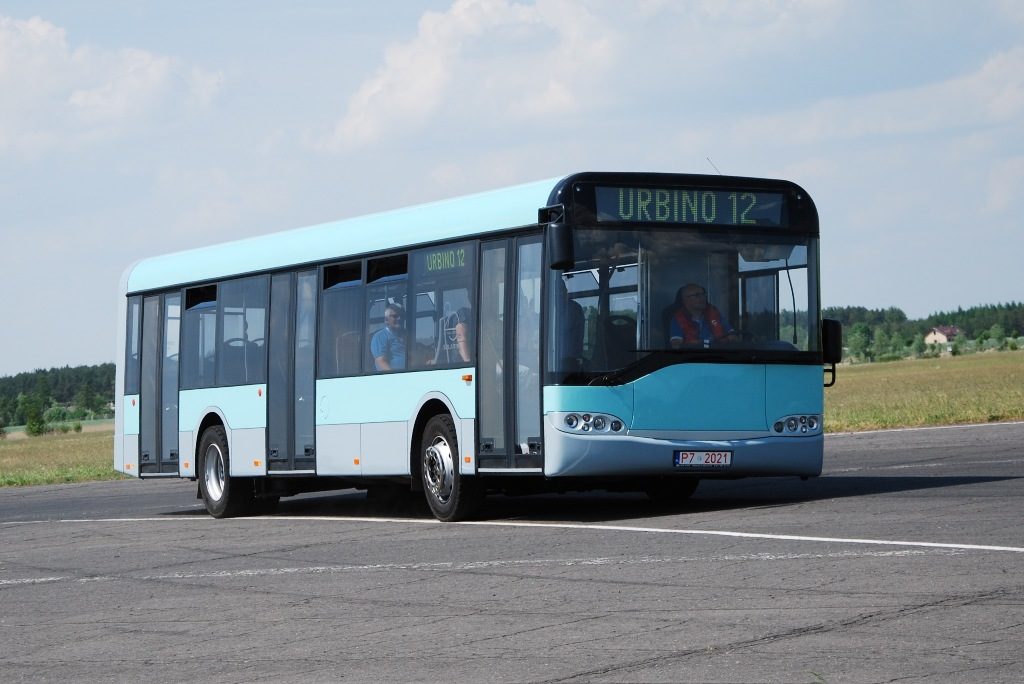
In 2020, Solaris became Europe’s largest electric bus manufacturer, by delivering 412 electrically powered vehicles to the domestic markets. BYD sold 418, but BYD is not European; it is Chinese.
Solaris was able to book larger new orders (see above for SWS Solingen), but new public transport companies were also added as customers. The Bonn SWB, for example, received the first Solaris in its history: the Urbino 18 electric coaches 2033 to 2035 are also the SWB’s first electric articulated buses.
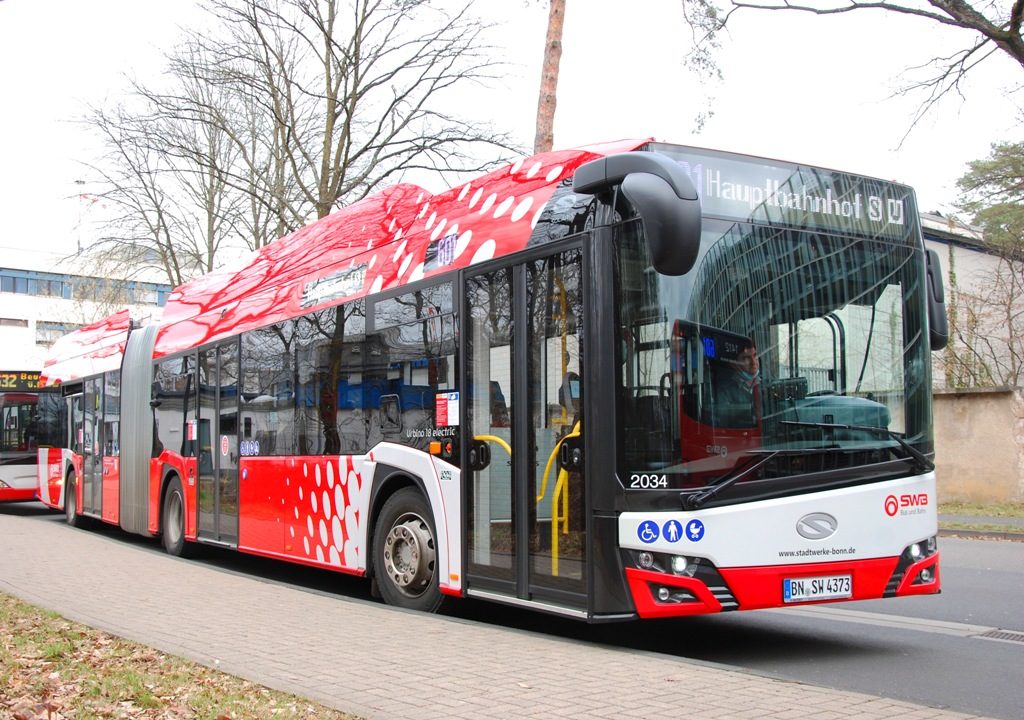
.
VDL
The bus manufacturer VDL, with factories in the Netherlands and Belgium, has produced its Citea low-floor bus series for many years. The new generation of the Citea will now be presented in autumn.
VDL is taking a remarkable step with the new generation of the Citea, as the new Citea will only be available with electric drive. A manufacturer is completely giving up with the traditional diesel engine.
And as with Ebusco, the batteries – which must have been “knocked flat” – will go under the floor. At the same time, in the interest of a longer range, the weight of the car is reduced by using a sandwich structure for the side walls.
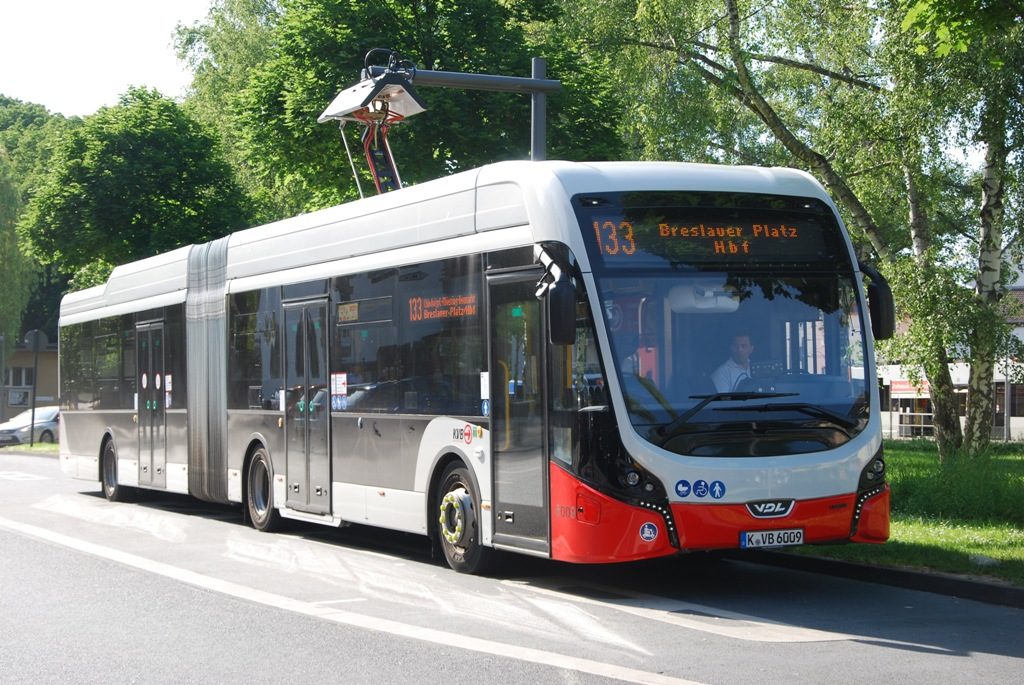
Also represented at the ElekBu 2021 was the non-profit association trolley:motion, which promotes about sustainable urban mobility solutions, especially those based on trolleybus systems – more about it here: https://www.trolleymotion.eu/trolleybusse-bestandteil-der-elekbu-2021-onlinekonferenz/
05.04.2021
